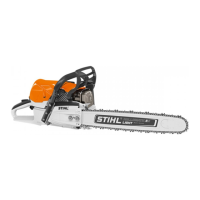0458-790-8221-A
16
English
5 IMPORTANT SAFETY INSTRUCTIONS
■ To reduce the risk of injury to bystanders and
unauthorized users:
– Never leave the chain saw unattended when the
engine is running.
– Shut off the engine and engage the chain brake
during work breaks and any other time the chain saw
is not in use.
■ To reduce the risk of fire and explosion:
– Never operate the chain saw in a location where
combustible gases, liquids, vapors, dusts or other
combustible materials and substances are present.
– Always move the Master Control Lever to stop
position 0 before pulling the starter grip if the spark
plug boot has been removed.
– Read and follow recommendations issued by
government authorities for identifying and avoiding
the hazards of combustible gases, liquids, vapors,
dusts or other combustible materials and
substances.
– Never modify the chain saw muffler or spark
arresting screen.
■ If a rotating chain strikes a rock or other hard object,
sparks may be created, which can ignite flammable
materials under certain circumstances. Flammable
materials can include dry vegetation and brush,
particularly when weather conditions are hot and dry.
– When there is a risk of fire or wildfire, do not use your
chain saw around flammable materials or around dry
vegetation or brush.
– Contact your local fire authorities or the Canadian
Forest Service if you have any question about
whether vegetation and weather conditions are
suitable for the use of a chain saw.
■ As soon as the engine is running, it generates toxic
exhaust gases containing chemicals, such as unburned
hydrocarbons (including benzene) and carbon monoxide,
that are known to cause respiratory problems, cancer,
birth defects, or other reproductive harm. Some of the
gases (e. g. carbon monoxide) may be colorless and
odorless. To reduce the risk of serious or fatal injury or
illness from inhaling toxic exhaust gases:
■ Using this chain saw and sharpening its chain can
generate dust, oil mist and other substances containing
chemicals known to cause respiratory problems, cancer,
birth defects and other reproductive harm.
– Consult governmental agencies such as ECCC,
CCOHS and PHAC and other authoritative sources
on hazardous materials if you are unfamiliar with the
risks associated with the particular substances you
are cutting or with which you are working.
■ Inhalation of certain dusts, especially organic dusts such
as mold or pollen, can cause susceptible persons to have
an allergic or asthmatic reaction. Substantial or repeated
inhalation of dust or other airborne contaminants,
especially those with a smaller particle size, may cause
respiratory or other illnesses. This includes wood dust,
especially from hardwoods, but also from some softwoods
such as Western Red Cedar.
– Control dust (such as saw dust) and mists (such as
oil mist from chain lubrication) at the source where
possible.
– Always work with a properly sharpened chain, which
produces wood chips rather than fine dust.
– To the extent possible, operate the chain saw so that
the wind or operating process directs any dust, mist
or other particulate matter raised by the chain saw
away from the operator.
– When respirable dust or other particulate matter
cannot be kept at or near background levels, always
wear a respirator that is approved by PHAC and
rated for worksite-specific conditions. Follow the
– Never operate the chain saw indoors, in
confined spaces or other poorly
ventilated locations.
– If exhaust fumes become concentrated
due to insufficient ventilation, clear
obstructions from the work area. Ensure
proper ventilation before proceeding.

